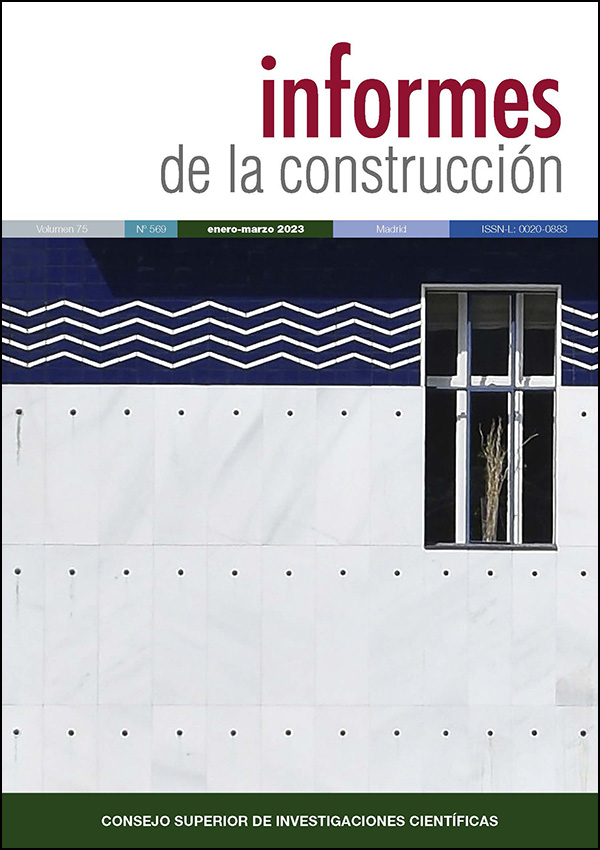Annoying glare in fabrics: metrics based on saturation and/or contrast effect
DOI:
https://doi.org/10.3989/ic.91757Keywords:
daylight, glare, fabrics, shading systemsAbstract
The level of glare produced by nine textiles was evaluated. This type of shading system is often marketed without an adequate photometric characterization, which leads to an inadequate application. This results in higher visual discomfort for users and higher energy consumption. In order to evaluate glare, four different metrics were calculated. These metrics are based on the effect of saturation, contrast or both. It was also evaluated which metric should be used: one specific to the prevailing light condition, a general metric applicable to all light conditions, or a combination of both. In this study it was observed that the contrast metric was more sensitive to glare, but the use of two metrics in an additive way provides a better ranking of textiles. As a final objective, a scoring system is proposed to evaluate the glare performance of textiles.
Downloads
References
(1) Konstantzos, I., Tzempelikos, A. (2017). Daylight glare evaluation with the sun in the field of view through window shades. Build Environ. 113, 65-77. https://doi.org/10.1016/j.buildenv.2016.09.009
(2) Tuaycharoen, N. (2011). Windows are less glaring when there is a preferred view. 09(01), 45-55. https://doi.org/10.4038/besl.v9i1-2.3064
(3) Webb, A.R. (2006). Considerations for lighting in the built environment: Non-visual effects of light. Energy Build. 38(7), 721-7. https://doi.org/10.1016/j.enbuild.2006.03.004
(4) Villalba, A.M., Pattini, A.E., Córica, M.L. (2012). Análisis de las características morfológicas de las envolventes edilicias y del entorno urbano desde la perspectiva de la iluminación natural. Ambient Construído. 12(4), 159-75. https://doi.org/10.1590/S1678-86212012000400011
(5) Tzempelikos, A., Shen, H. (2013). Comparative control strategies for roller shades with respect to daylighting and energy performance. Build Environ. 67, 179-92. https://doi.org/10.1016/j.buildenv.2013.05.016
(6) Konstantzos, I., Tzempelikos, A., Chan, Y.C. (2015). Experimental and simulation analysis of daylight glare probability in offices with dynamic window shades. Build Environ. 87, 244-54. https://doi.org/10.1016/j.buildenv.2015.02.007
(7) Yamin Garreton, J., Villalba, A.M., Rodríguez, R.G., Pattini, A. (2021). Roller blinds characterization assessing discomfort glare, view outside and useful daylight illuminance with the sun in the field of view. Sol Energy. 213, 91-101. https://doi.org/10.1016/j.solener.2020.11.027
(8) Jakubiec, J.A., Reinhart, C.F. (2016). A concept for predicting occupants' long-term visual comfort within daylit spaces. Leukos. 12(4), 185-202. https://doi.org/10.1080/15502724.2015.1090880
(9) Van Den Wymelenberg, K.G. (2014). Visual comfort, discomfort glare, and occupant fenestration control: Developing a research agenda. Leukos [Internet]. 2014 Aug 8 [cited 2015 Dec 4]. 10(4), 207-21. https://doi.org/10.1080/15502724.2014.939004
(10) Wienold, J., Christoffersen, J. (2006). Evaluation methods and development of a new glare prediction model for daylight environments with the use of CCD cameras. Energy Build. 38(7), 743-57. https://doi.org/10.1016/j.enbuild.2006.03.017
(11) Wienold, J. (2009). Daylight glare in offices PhD thesis. Universität Karlsruhe.
(12) Wienold, J., Iwata, T., Sarey-Khanie, M., Erell, E., Kaftan, E., Rodriguez, R.G., et al. (2019). Cross-validation and robustness of daylight glare metrics. Light Res. Technol. 51(7). https://doi.org/10.1177/1477153519826003
(13) Konstantzos, I., Tzempelikos, A. (2014). Daylight glare probability measurements and correlation with indoor illuminances in a full-scale office with dynamic shading controls.
(14) Einhorn, H.D. (1979). Discomfort glare: a formula to bridge differences. Light Res Technol. 11(2), 90-4. https://doi.org/10.1177/14771535790110020401
(15) Hopkinson, R.G., Collins, J.B. (1963). The prediction and avoidance of glare in interior lighting. Ergonomics. 6(4), 379-83. https://doi.org/10.1080/00140136308930712
(16) Shafavi, N.S., Zomorodian, Z.S., Tahsildoost, M., Javadi, M. (2020). Occupants visual comfort assessments: A review of field studies and lab experiments. Sol Energy. 208, 249-74. https://doi.org/10.1016/j.solener.2020.07.058
(17) Pierson, C., Wienold, J., Bodart, M. (2017). Discomfort glare perception in daylighting: influencing factors. Energy Procedia. 122, 331-6. https://doi.org/10.1016/j.egypro.2017.07.332
(18) Kotey, N.A., Wright, J.L, Collins, M.R. (2009). Determining off-normal solar optical properties of roller blinds.
(19) Yamin Garretón, J.A., Colombo, E.M., Pattini, A.E. (2018). A global evaluation of discomfort glare metrics in real office spaces with presence of direct sunlight. Energy Build. 166. https://doi.org/10.1016/j.enbuild.2018.01.024
(20) Wienold, J. Evalglare (version v1.22). 2015. p. 1-4.
(21) DiLaura, D.L., Houser, K.W., Mistrick, R.G. (2011). The lighting handbook reference and application. The lighting handbook reference and application. New York (NY): Illuminating Engineering Society of North America. 1328 p. Illuminating Engineering Society of North America New York (NY). 1328.
Published
How to Cite
Issue
Section
License
Copyright (c) 2023 Consejo Superior de Investigaciones Científicas (CSIC)

This work is licensed under a Creative Commons Attribution 4.0 International License.
© CSIC. Manuscripts published in both the print and online versions of this journal are the property of the Consejo Superior de Investigaciones Científicas, and quoting this source is a requirement for any partial or full reproduction.
All contents of this electronic edition, except where otherwise noted, are distributed under a Creative Commons Attribution 4.0 International (CC BY 4.0) licence. You may read the basic information and the legal text of the licence. The indication of the CC BY 4.0 licence must be expressly stated in this way when necessary.
Self-archiving in repositories, personal webpages or similar, of any version other than the final version of the work produced by the publisher, is not allowed.
Funding data
Consejo Nacional de Investigaciones Científicas y Técnicas
Grant numbers ANPCYT;PICT-2018-03269;PICT-2017-1088;PICT-2018-02080;PICT-2019-04356















